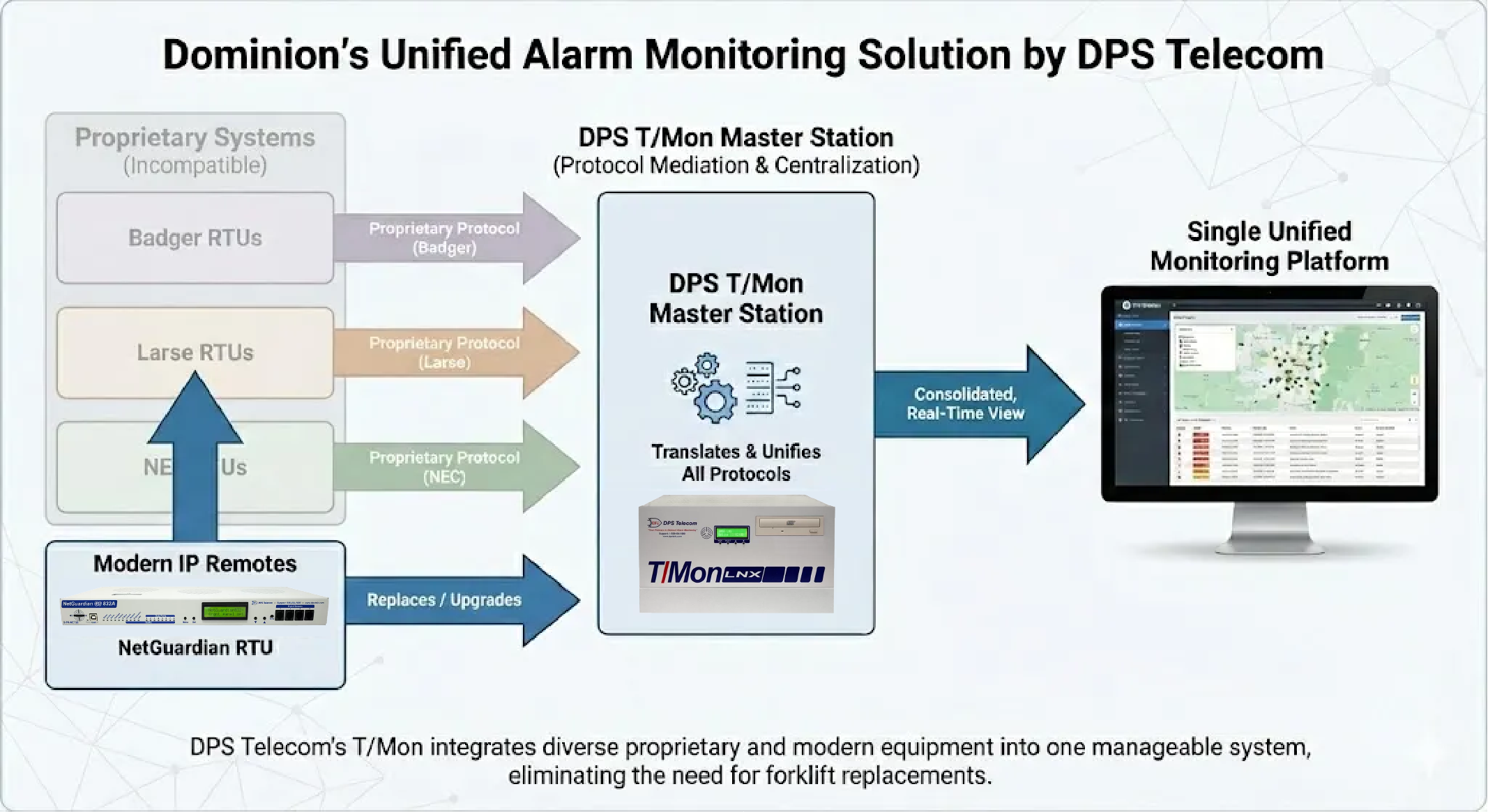Check out our White Paper Series!
A complete library of helpful advice and survival guides for every aspect of system monitoring and control.
1-800-693-0351
Have a specific question? Ask our team of expert engineers and get a specific answer!
Sign up for the next DPS Factory Training!

Whether you're new to our equipment or you've used it for years, DPS factory training is the best way to get more from your monitoring.
Reserve Your Seat TodayVirginia utility unifies three incompatible systems into one platform
| Field | Details |
|---|---|
| Industry | Electric Utility Infrastructure |
| Company Type | Regional Energy Distribution Company |
| Geography/Coverage | 150 sites across seven states |
| Primary Challenge | Three incompatible monitoring systems in production |
| Solution Deployed | Multi-protocol master station integration |
| Key Result | Single unified monitoring platform across all sites |
| Implementation Timeframe | Nine-month deployment |
| Products Used | T/Mon Master Station with protocol mediation |
Dominion is a Virginia-based energy company. They operate an extensive internal communications network across seven states. This network supports voice communications and SCADA telemetry data. Their network plays an important role in guaranteeing reliable electricity service across 150 remote sites.
Dominion's monitoring infrastructure had evolved into a fragmented system. This created operational inefficiencies. Remote monitoring equipment at 150 sites relied on incompatible systems from three manufacturers: Badger, Larse, and NEC. These systems couldn't communicate with each other. This made centralized management impossible.
"We wanted to replace all the masters with one master," said Dan Jackson, Lead Telecommunications Technician.
DPS Telecom designed a monitoring system that incorporated Dominion's existing remote equipment. This avoided costly forklift replacement. The custom-engineered platform unified all three incompatible systems under a single T/Mon master station. This gave Dominion the centralized visibility they needed.
The solution centered on DPS Telecom's ability to support multiple proprietary protocols simultaneously. DPS didn't force Dominion to adapt their infrastructure. Instead, DPS engineered a platform that adapted to Dominion's needs.
"The thing I liked was that DPS was going to make it fit our needs. They weren't going to try to make our stuff fit their stuff. They were going to make their stuff fit ours," said Jackson.

Dominion achieved their goal of unified network monitoring across all 150 sites. They now operate a single, full-featured monitoring platform. This platform consolidates data from previously incompatible systems. The system maintains the ability to expand as future needs evolve.
| Metric | Result |
|---|---|
| System Consolidation Achieved | Three separate systems unified into one |
| Sites Successfully Integrated | 150 locations across seven states |
| Existing Equipment Protected | All existing remotes retained and integrated |
| Future Scalability Enabled | Platform ready for expansion and upgrades |
"We had several different types of proprietary remotes: Badger, Larse, NEC. DPS was going to make it fit our needs," Jackson noted.
Dan Jackson, Lead Telecommunications Technician, Dominion
| Benefit | Description |
|---|---|
| Avoided Costly Replacement | Retained all existing remote equipment and site infrastructure investments |
| Unified Management Platform | Single platform replaced three separate incompatible monitoring systems |
| Future-Ready Architecture | Modern system architecture supports continued growth and technology migration |
| Custom Integration Approach | Solution adapted to client infrastructure rather than forcing replacement |
T/Mon Master Station - Multi-protocol alarm management platform that unifies monitoring across incompatible equipment.
NetGuardian RTUs - Native IP remotes for sites transitioning to modern network monitoring.
Protocol mediation translates proprietary communication formats into a common standard your master station can understand. DPS Telecom supports 30+ protocols, allowing equipment from various manufacturers to work together seamlessly. This approach preserves your infrastructure investment while providing unified visibility.
Yes. Modern monitoring platforms can support both traditional discrete alarm inputs and IP-based monitoring simultaneously. You can migrate sites to IP connectivity as budget and infrastructure allow while maintaining monitoring coverage for all locations during the transition.
A multi-protocol master station protects you by providing ongoing monitoring capability even after manufacturer support ends. When manufacturers discontinue equipment, they typically stop providing parts, software updates, and technical assistance. Protocol mediation ensures your monitoring continues while giving you time to plan upgrades.
For a network of 150+ sites like Dominion's, implementation typically takes several months from initial design through full deployment. Project timelines depend on your specific requirements and the number of sites involved. The system can often be implemented in phases, providing immediate benefits as each section comes online.
Integration through protocol mediation typically offers the best return on investment if your existing equipment functions reliably. This approach provides modern centralized management while avoiding replacement costs. Complete replacement makes sense when equipment has reached end-of-life or operational requirements have changed significantly.
If you're managing multiple incompatible monitoring systems across your network, we can help design a unified solution that preserves your infrastructure investment.
Or call us: 1-800-622-3314